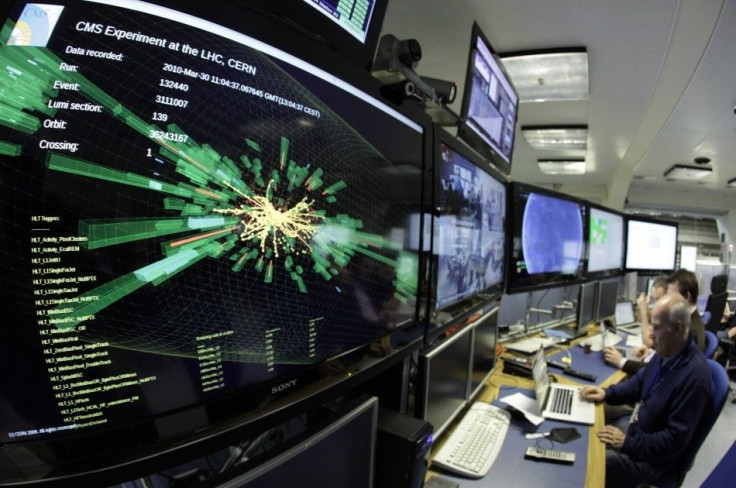Hopes of Finding ‘God Particle’ Higgs Boson Fade

Physicists’ hunt for science's modern day Holy Grail, Higgs boson, is getting harder as new data from the Large Hadron Collider (LHC) has shown that the 'God particle' doesn't' exist in a wide range of possible masses.
At this moment we don't see any evidence for the Higgs in the lower mass region where it is likely to be ... I think it is true that the hints that we saw in July are not as significant -- they weren't very significant in July -- but they have gotten less significant now, LHC scientist Howard Gordon told AFP.
According to New scientist, data from the LHC's ATLAS and CMS detectors have now ruled out all masses for the Higgs between 145 and 466 gigaelectronvolts (GeV). That covers the bulk of the mass range that is easiest for physicists to explore.
The latest development is a huge slide from the position of confidence physicists enjoyed in July. Scientists believed then that the 40-year search for the God particle was tantalizingly close to the end as they reported that results of atom-smashing at the LHC hinted at the existence of the Higgs boson.
Now, speaking at the biennial Lepton-Photon conference in Mumbai, India, CERN spokesman James Gillies said: We're ruling out the easy bits, and we're leaving the harder bits still to study ... There's still a lot of space left, but it's the space that's harder for us to analyse.
In July, it looked like physicists at two facilities in the world that work on finding the Higgs boson were about to close in on the elusive particle.
The LHC scientists had said they could trace some unusual results that possibly hinted at the existence of the missing God particle, when streams of protons were fired through the LHC particle accelerator.
A similar assessment from the Tevatron particle accelerator at the Fermi National Accelerator Laboratory in Illinois sent the message that physicists the world over were on the right track in their search of the elusive particle.
Fermilabs scientists said the CDF and DZero experiments could exclude the existence of a Higgs particle in the 100-108 and the 156-177 GeV/c2 mass ranges. It also pointed out that the European experiments had led to the exclusion of Higgs particle with a mass of about 150 to 450 GeV/c2, confirming the Tevatron exclusion range.
This leaves a narrow window for the Higgs particle, and the Tevatron experiments are on track to collect enough data by the end of September 2011 to close this window if the Higgs particle does not exist, Fermilabs said.
Scientists at both facilities expressed hope that they would be able to make a final call on the existence of Higgs boson within months, after analysing huge chunks of data.
I hope the big discoveries will come next year ... I would say we can settle the question, the Shakespearean question — ‘to be or not to be’ — by the end of next year, said Rolf Heuer, director-general of the CERN research centre.
Now physicists are less certain about the eventual outcome. We are definitely approaching the end game in looking for the Higgs ... But we don't want to give the impression that the answer is just around the corner, Gillies said in Mumbai.
He said physicists at the LHC will have to analyse larger bulk of data to say for sure if Higgs boson exists. And that may take at least a year if everything works fine.
Basically the data has increased by about a factor of two since the report from the European Physical Society meeting in July because the Large Hadron Collider is producing lots of data, said Gordon.
I think it has always been a possibility that the Higgs would not be there but I don't think we are ready to say that at this moment, he added.
If scientists finally conclude that the God particle does not exist it will be a huge letdown for physicists. Higgs boson is the lynchpin of the modern particle physics theory called the Standard Model. Scientists have always hoped that the discovery of Higgs boson will help them answer long-held questions like what is the source of mass and why some particles have mass and others don't have.
Higgs boson is the particle that is deemed to be giving mass to other particles. The secret behind the particles, or matter, having mass or not having it is hidden inside the Higgs boson.
It will also help scientists throw light on the supersymmetric particles and thereby throw light on the investigation into the make-up of dark matter.
Higgs boson, the sub-atomic particle fundamental to the understanding the nature of matter, was first hypothesized in 1964 by Edinburgh University physicist Peter Higgs. The Standard Model theory built the framework in modern times for the understanding of the way the universe, with the help of the Higgs boson hypothesis. It offered the notional structure of the nature of matter and how the universe came into being.
Discoveries are almost assured within the next 12 months. If the Higgs exists, the LHC experiments will soon find it. If it does not, its absence will point the way to new physics, said CERN research director Sergio Bertolucci.
© Copyright IBTimes 2024. All rights reserved.











